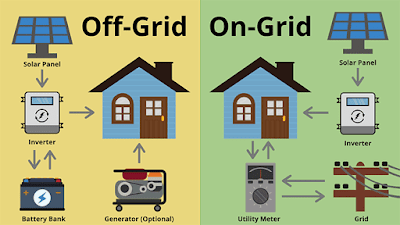
As solar panels become cheaper and cheaper, solar power is growing to unprecedented heights and is the future power of coal and other fossil fuels. It is imperative to take advantage of this opportunity to switch to solar power to save on your monthly electricity bills. Follow the steps below for your first step to go solar, which determines the type and size of the solar energy system for your home. How do solar panels work?
You first need to know that a typical solar-powered home has 3 types of solar power system options, each with its own level of complexity, cost, and benefits. That is why the first step to going solar is deciding what type of home you want. Here are those 3 types, their description, and advantages and disadvantages.

1) On-grid system is connected to the electric grid. Your home will then have 2 sources of energy: your solar energy system and the electrical grid. In the morning, your home will power your devices with the energy generated by solar. If this is not enough, your home will get a deficit from the electric grid. In the afternoon, your solar generates more energy than your home's energy demands at that time. When this happens, the excess energy is exported back to the electric grid. If you have a net metering system, you will be credited a certain amount for all the energy you export and this credit will be deducted from your next electricity bill. At night, you usually get energy from the electric grid without solar.
The main advantage of on-grid systems is that it is simpler and therefore cheaper. You don't need batteries for your night time use or cloudy days. Also, it is more reliable to supply power from your home as you always have an electric grid backed up. You never have to worry about whether your solar can power your devices at any time.
The disadvantage of on-grid systems is that you still rely on the electric grid. Therefore, on-grid systems cannot be installed in remote locations. Also, when there is a power outage, the on-grid systems are automatically shut down as they are connected to the electric grid, making them useless in these situations.
2) Off-grid - As its name suggests, off-grid systems allow homes to move off the grid or disconnect from the electrical grid and operate on their own. To do this, this type of system requires the use of batteries or a Tesla Power Wall. Solar panels are sized so that in the daytime, it produces more energy than your daylight consumption. The extra power is used to charge your batteries and then used for your nighttime use.
The advantage of off-grid systems is that you are completely independent of the electric grid. Since you are already generating energy for your home, you will never have to pay for electric bills again. Also, you are not affected by power outages.
However, in spite of all those advantages, off-grid systems are complex to operate and maintain. This aside, it can be quite expensive as the system needs to be heavy to replace the extra batteries and low-radiation months (winter and rainy season).
3) Hybrid Systems - This type of system is a combination of on-grid and off-grid systems and allows the homeowner to enjoy the benefits of both systems. It is connected to an electric grid, such as an on-grid system, and also has batteries to serve as backup during power outages. Unlike off-grid systems, batteries of hybrid systems are usually reserved for these cases.
The advantage of hybrid systems is that you get the best of both worlds. Because you are still connected to the grid, you have the reliability of on-grid systems. With this, you will still have no problems supplying energy to your home when your solar generates enough power. Also, because you have batteries, you still have a power supply when there are power outages.
If set aside, you can use hybrid systems to take advantage of the tariff time. The tariff of consumption refers to having different power rates depending on the time of day. The rate at pre-defined times is called "off-peak hours" and is highest during "peak hours". Using the hybrid system, you can charge your batteries with electricity from the grid during off-peak times for your own consumption. Doing so will increase the savings you get from using solar energy.
As with off-grid systems, hybrid systems are difficult to operate and maintain as you also have batteries. Although not as expensive as off-grid systems, they are also expensive.
By knowing the different types of solar power systems and their associated advantages and disadvantages, you will be able to give you information on what you want in your home. However, you also need to consider the specific cost of each system and for that, you should get a quote from various solar entrepreneurs.